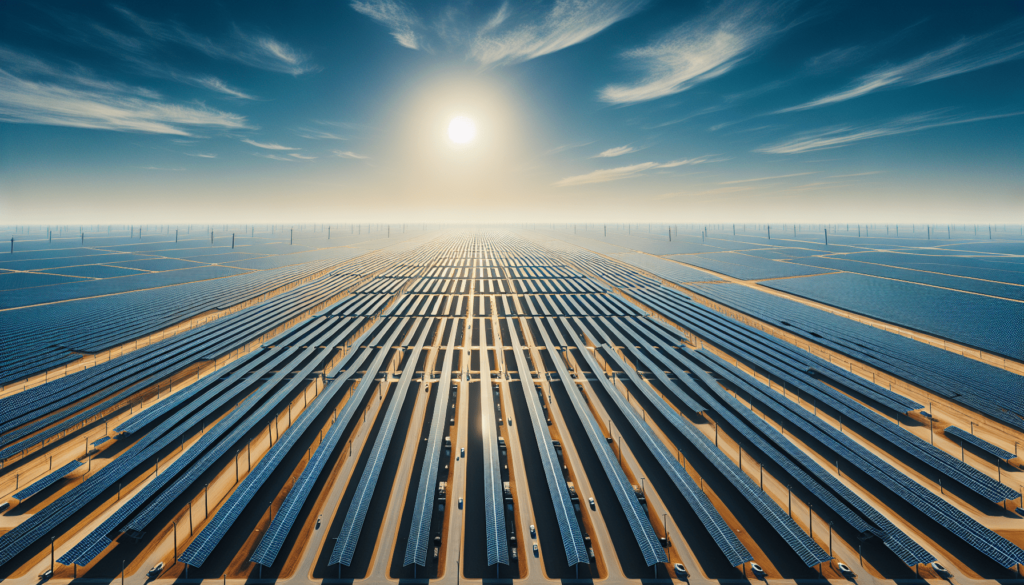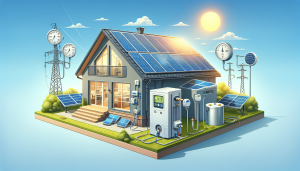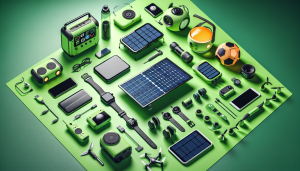Solar farms, fascinating wonders of modern technology, have been rapidly emerging across the globe. As we bask in the glow of the sun’s powerful rays, we’ve also come to realize the immense potential of harnessing its energy to generate electricity. But what exactly are solar farms? These innovative sites, often located in sunny regions, consist of vast fields adorned with rows upon rows of solar panels. They work diligently, soaking up sunlight and converting it into clean, sustainable energy that can power thousands of homes and businesses. Join us on a journey to explore the intricacies of solar farms and unveil their remarkable impact on our world.

Definition of Solar Farms
Explanation of solar farm concept
Solar farms, also known as solar power plants or solar parks, are large-scale installations specifically designed to harness the power of sunlight and generate electricity on a commercial level. These vast expanses of land are covered with thousands of solar panels, which absorb sunlight and convert it into usable energy. Unlike residential solar systems, which are typically installed on rooftops, solar farms are built on open land, allowing for maximum exposure to the sun’s rays.
Description of solar farm components
Solar farms consist of several key components that work together to generate electricity. The primary component is the solar panel, or photovoltaic module, which is made up of multiple solar cells. These cells are responsible for converting sunlight into direct current (DC) electricity. Inverters are another important component of solar farms, as they convert DC electricity into alternating current (AC), which can be used to power homes and businesses. Additionally, mounting structures hold the solar panels in place, while tracker systems help optimize the angle of the panels to maximize sunlight absorption. Electrical systems, transformers, and monitoring and control systems complete the setup, ensuring the efficient operation of the solar farm.
Overview of how solar farms work
Solar farms generate electricity through the process of photovoltaics. When sunlight hits the solar panels, it excites electrons within the solar cells, creating an electric current. This direct current is then converted into alternating current by the inverters, making it suitable for use in the electrical grid. The generated electricity can then be transmitted to households, businesses, or even sold back to utilities. Solar farms can operate autonomously, relying solely on sunlight to generate electricity, or they can be connected to the grid, allowing for a more reliable power supply.
Types of Solar Farms
Utility-scale solar farms
Utility-scale solar farms are the most common type of solar farms found worldwide. These large installations are typically developed and operated by utility companies or independent power producers. Utility-scale solar farms are capable of generating a significant amount of electricity, often in the range of tens or hundreds of megawatts. The electricity generated by these solar farms is then fed into the electrical grid and distributed to consumers.
Community solar farms
Community solar farms, also known as solar gardens or shared solar projects, are designed to allow multiple individuals or organizations to benefit from a single solar farm. In this model, participants can subscribe to a share of the solar farm’s electricity production, either through purchasing or leasing agreements. This allows individuals who are unable to install solar panels on their own properties or who rent their homes to still access the benefits of solar energy.
Small-scale or rooftop solar farms
Small-scale or rooftop solar farms involve the installation of solar panels on individual buildings or structures, such as residential homes, commercial buildings, or parking lots. While these installations may not generate as much electricity as utility-scale solar farms, they still contribute to the overall renewable energy generation. Rooftop solar farms are popular, especially in urban areas, due to their ability to utilize existing space without the need for additional land.
Floating solar farms
Floating solar farms, also known as floating solar arrays or floating photovoltaic systems, are a relatively new type of solar farm that is gaining popularity. These solar farms are installed on bodies of water, such as lakes, reservoirs, or ponds, using floating structures. Floating solar farms have several advantages, including minimizing land use, reducing water evaporation, and increasing energy production due to the cooling effect of the water. They also provide an opportunity to utilize unused or underutilized water surfaces for renewable energy generation.

Benefits of Solar Farms
Renewable and clean energy source
Solar farms offer the significant advantage of utilizing a renewable and clean energy source. Unlike fossil fuels, such as coal or natural gas, solar energy produces no greenhouse gas emissions or air pollutants during generation, contributing to the reduction of greenhouse gas emissions and improving air quality. Solar power is also an abundant energy source, as it relies on sunlight, which is available almost everywhere on Earth.
Reduced carbon emissions
One of the primary benefits of solar farms is their ability to reduce carbon emissions. By generating electricity directly from sunlight, solar farms eliminate the need for fossil fuel combustion, which is a major source of greenhouse gas emissions. As a result, solar farms play a vital role in combatting climate change and achieving carbon neutrality goals.
Job creation and economic benefits
The development and operation of solar farms have significant economic benefits. These projects require a skilled workforce for installation, maintenance, and management, creating employment opportunities and stimulating local economies. Additionally, solar farms can generate revenue for landowners and communities through lease agreements or power purchase agreements with utilities.
Enhancing energy independence
Solar farms play a crucial role in enhancing energy independence by reducing reliance on fossil fuel imports and volatile energy markets. By harnessing the power of sunlight, countries and communities can generate their own electricity, reducing dependence on foreign energy sources and mitigating the risks associated with fluctuating energy prices.
Challenges and Limitations
Initial high setup costs
One of the primary challenges of solar farms is the high initial setup costs. The cost of solar panels, inverters, mounting structures, and other necessary components can be substantial, making it challenging for some organizations or individuals to finance a solar farm project. However, as solar technology continues to advance and economies of scale are achieved, the cost of solar farm installations is gradually decreasing, making them a more financially viable option in the long run.
Land and space requirements
Solar farms require a significant amount of land to accommodate the large number of solar panels. Finding suitable land that is both sunny and accessible can be a challenge, particularly in densely populated areas or regions with competing land-use priorities. Additionally, solar farms must be strategically located to minimize shading from nearby structures or vegetation, as shadows can significantly reduce energy production.
Intermittency of solar energy
One limitation of solar farms is their reliance on sunlight, which leads to the intermittency of energy generation. Solar energy production is dependent on weather conditions, with energy output decreasing during cloudy days or at night. Energy storage systems, such as batteries, are often used to mitigate the impact of intermittency by storing excess energy generated during peak sunlight hours for use during low or no sunlight periods.
Potential environmental impacts
While solar farms are generally considered environmentally friendly, certain environmental impacts should be taken into consideration. The installation of solar panels and associated infrastructure can result in the clearing of vegetation and habitat disruption. However, proper site selection, planning, and implementation of mitigation measures can help minimize these impacts and promote the coexistence of solar farms with the surrounding environment.

Solar Farm Development Process
Site selection and land acquisition
The first step in developing a solar farm is selecting an appropriate site. Factors such as solar resource availability, land size and topography, proximity to electrical infrastructure, and local zoning regulations are taken into consideration during the site selection process. Once a suitable site is identified, the developer must secure the necessary land rights through leases, purchases, or long-term agreements.
Permitting and approvals
Solar farm development requires various permits and approvals from local, state, and federal authorities. These permits ensure compliance with environmental, land use, construction, and electrical regulations. Typically, an environmental impact assessment or similar study is conducted to evaluate and mitigate any potential adverse effects on the environment or local communities. Engaging with stakeholders and soliciting public input also form part of the permitting and approval process.
Design and engineering
The design and engineering phase of solar farm development involves detailed planning and layout of the solar panels, inverters, mounting structures, electrical systems, and other components. Design considerations include optimizing the orientation and tilt angle of the panels to maximize sunlight absorption, ensuring proper spacing between panels, and designing an efficient electrical system to transmit the generated electricity.
Construction and installation
Once the design phase is complete, construction and installation can begin. This involves clearing and leveling the site, installing the mounting structures, placing the solar panels, and assembling the electrical and monitoring systems. Construction teams work collaboratively to ensure that all components are installed correctly and safely. Quality control measures are implemented throughout the construction process to ensure that the solar farm is built to industry standards.
Grid connection
After construction is completed, the solar farm must be connected to the electrical grid. This involves installing transformers and electrical equipment to connect the solar farm to the grid infrastructure. Grid connection ensures that the electricity generated by the solar farm can be transmitted to end-users, such as homes, businesses, or utilities. Proper grid connection also allows for the monitoring and management of the solar farm’s electricity output.
Key Components of Solar Farms
Solar panels or photovoltaic modules
Solar panels, also known as photovoltaic modules, are the essential component of a solar farm. These panels consist of multiple solar cells, typically made from silicon, that convert sunlight into electricity through the photovoltaic effect. Solar panels are interconnected to generate usable electricity, and their numbers can range from a few thousand to millions, depending on the size of the solar farm.
Inverters
Inverters play a crucial role in converting the direct current (DC) electricity produced by the solar panels into alternating current (AC) electricity, which is suitable for use in the electrical grid. Inverters are responsible for ensuring the quality and stability of the generated electricity and are typically installed close to the solar panels to minimize power losses.
Mounting structures
Mounting structures are used to securely hold the solar panels in place on the ground or other surfaces. These structures provide the necessary support and elevation for the solar panels to optimize their exposure to sunlight. Mounting structures can vary in design, with options such as fixed-tilt, single-axis, and dual-axis systems, each offering different levels of flexibility and tracking capability.
Tracker systems
Tracker systems are mechanisms that allow solar panels to follow the sun’s movement throughout the day. By adjusting the angle and orientation of the solar panels to maximize their exposure to sunlight, tracker systems can significantly increase energy output compared to fixed-tilt systems. Tracker systems can be either single-axis, which tracks the sun’s east-to-west movement, or dual-axis, which also accounts for the sun’s inclination angle.
Electrical systems and transformers
Electrical systems and transformers are crucial components that ensure the efficient transmission of electricity generated by the solar panels. These systems include cables, circuit breakers, switchgear, and transformers to step up the voltage of the generated electricity for transmission through the electrical grid. Proper electrical design and installation help minimize power losses and enable reliable energy delivery.
Monitoring and control systems
Monitoring and control systems are installed to monitor the performance and operation of the solar farm in real-time. These systems gather data on energy production, system health, and any potential issues, allowing for early detection and proactive maintenance. Monitoring and control systems also enable remote management and optimization of the solar farm’s output, contributing to its overall efficiency and reliability.

Maintenance and Operation of Solar Farms
Regular inspection and cleaning of panels
Regular inspection and cleaning of solar panels are important to ensure optimal performance. Dust, dirt, leaves, and bird droppings can accumulate on the panels over time, reducing their sunlight absorption efficiency. Inspecting the panels regularly for any signs of damage or degradation allows for timely repairs or replacements, while cleaning the panels helps maximize energy generation.
Monitoring system performance
Continuous monitoring of system performance is essential for identifying any potential issues and ensuring that the solar farm operates at its highest capacity. Monitoring systems provide real-time data on energy production, system output, and efficiency, enabling the detection of underperforming panels or equipment. By identifying and addressing performance issues promptly, the overall efficiency and output of the solar farm can be optimized.
Inverter maintenance and replacement
Inverters are critical components of a solar farm, and their regular maintenance is essential for long-term performance. Maintenance activities may include cleaning fan filters, inspecting electrical connections, and checking for any signs of wear or damage. Inverters have a finite lifespan, typically around 10 to 15 years, and periodic replacements may be necessary to ensure optimal performance.
Vegetation management
Managing vegetation around the solar farm is crucial to prevent shading of the solar panels. Regular vegetation management activities, such as trimming trees or shrubs, help minimize shading and maintain optimum sunlight exposure. Additionally, controlling weed growth within the solar farm area ensures the safety and accessibility of the site, facilitating efficient maintenance and operation.
Operational and safety procedures
Establishing operational and safety procedures is essential for the efficient and safe operation of a solar farm. These procedures include protocols for routine operations, emergency response, and equipment maintenance. Regular training and adherence to safety standards play a crucial role in preventing accidents and ensuring the well-being of employees and contractors working at the solar farm site.
Global Solar Farm Market
Overview of the solar farm market
The global solar farm market has experienced significant growth in recent years, driven by increasing investments in renewable energy and the growing recognition of solar power as a sustainable energy source. Solar farms are becoming increasingly cost-effective, with decreasing installation costs and improving technology efficiency. The market encompasses various stakeholders, including project developers, EPC (engineering, procurement, and construction) companies, equipment manufacturers, and investors.
Growth trends and projections
The solar farm market is projected to continue its upward growth trajectory in the coming years. Factors contributing to this growth include falling solar panel prices, advancements in solar technology, supportive government policies, and increasing public and corporate demand for clean energy. Frost & Sullivan estimates that the global solar farm market is expected to reach a capacity of over 1,000 GW by 2027, representing substantial growth opportunities.
Leading countries and companies
Several countries are leading the way in solar farm installations. China has been a global leader in solar energy, with a significant number of utility-scale solar farms installed. Other countries at the forefront of solar farm development include the United States, India, Japan, Germany, and Australia. In terms of companies, some prominent players in the solar farm market include JinkoSolar, Trina Solar, First Solar, Canadian Solar, and SunPower, among others.
Government policies and incentives
Government policies and incentives play a crucial role in promoting the development of solar farms. Many countries have implemented feed-in tariffs, tax incentives, and renewable energy targets to encourage the deployment of solar power plants. These policies create a favorable investment environment, attract private capital, and enable the growth of the solar farm market. Additionally, international agreements, such as the Paris Agreement, have reinforced the importance of renewable energy and provided further impetus for solar farm development.
Solar Farm Case Studies
Examples of successful solar farms
Numerous solar farm projects worldwide have demonstrated the success of this renewable energy technology. One example is the Kamuthi Solar Power Project in Tamil Nadu, India, which held the title of the world’s largest solar farm at the time of its completion. With a capacity of 648 MW, the project spans over 2,500 acres and consists of 2.5 million solar panels. The Tengger Desert Solar Park in China is another notable solar farm, generating 1.5 GW of electricity and covering an area of approximately 1,200 square kilometers.
Project highlights and achievements
Solar farm projects have achieved remarkable milestones, showcasing the potential and benefits of solar energy. The Noor Abu Dhabi Solar Power Plant in the United Arab Emirates, with a capacity of 1.18 GW, is the largest individual solar power plant in the world. The project, completed in 2019, is part of the country’s efforts to diversify its energy mix and reduce carbon emissions. Solar farms also play a crucial role in disaster-prone areas, as demonstrated by the Soma Solar Power Plant in Japan, which was built after the Fukushima nuclear disaster in 2011.
Lessons learned and best practices
Solar farm case studies provide valuable insights and lessons that can guide future solar farm projects. Effective planning, stakeholder engagement, and collaboration between government, industry, and local communities are essential for successful project implementation. Proper site selection, considering factors such as solar resource availability and compatible land use, is critical. Furthermore, incorporating advanced technology, ensuring efficient maintenance practices, and adhering to recognized industry standards contribute to the long-term success and viability of solar farms.
Future Outlook
Advancements in solar technology
Advancements in solar technology are expected to drive the future development and deployment of solar farms. Researchers and manufacturers are continually working to increase the efficiency of solar panels, reduce costs, and improve the overall performance of solar farms. Emerging technologies such as perovskite solar cells, tandem solar cells, and bifacial solar panels show promise for further enhancing the efficiency and durability of solar farm systems.
Integration with energy storage
The integration of energy storage systems with solar farms will play a crucial role in addressing the intermittency of solar energy and maximizing its utilization. Energy storage technologies, such as lithium-ion batteries, allow excess energy generated during peak sunlight hours to be stored and used during periods of low or no sunlight. The combination of solar farms and energy storage systems ensures a more reliable and continuous energy supply, increasing the overall value and viability of solar farm projects.
Emerging trends and innovations
Several emerging trends and innovations are shaping the future of solar farms. Agrovoltaics, which involve combining solar energy production with agricultural practices, offer dual land use and potential benefits for farmers. Hybrid solar farms, integrating solar power with other renewable energy sources like wind or geothermal, provide a more diversified and balanced energy mix. Additionally, data analytics, artificial intelligence, and automation are being leveraged to optimize the efficiency and performance of solar farms, enabling predictive maintenance and enhanced energy yield.
The role of solar farms in a sustainable future
Solar farms are set to play a vital role in the transition towards a sustainable and low-carbon future. As countries and communities strive to reduce greenhouse gas emissions, increase energy efficiency, and promote renewable energy sources, solar farms provide a clean and abundant energy solution. Their scalability, compatibility with existing infrastructure, and ability to create jobs and foster economic growth make solar farms an integral component of a sustainable energy landscape. By harnessing the power of the sun, solar farms contribute to a greener planet and a more resilient energy system for future generations.
In conclusion, solar farms are large-scale installations that harness sunlight to generate electricity. They come in different types, from utility-scale to community and rooftop installations, and even floating solar farms. Solar farms offer numerous benefits, including renewable energy generation, reduced carbon emissions, job creation, and enhanced energy independence. However, challenges such as high setup costs, land requirements, intermittency, and potential environmental impacts must be addressed. The solar farm development process involves site selection, permitting, design, construction, and grid connection. Key components of solar farms include solar panels, inverters, mounting structures, trackers, electrical systems, and monitoring equipment. Maintenance and operation of solar farms require regular inspection, cleaning, and maintenance of panels, monitoring system performance, and upkeep of inverters. The global solar farm market is rapidly growing, with various countries, companies, and government policies driving its expansion. Successful solar farm case studies highlight achievements and best practices, while advancements in solar technology, energy storage integration, emerging trends, and the role of solar farms in a sustainable future shape the industry’s outlook. With their increasing importance in the renewable energy landscape, solar farms contribute to a cleaner, greener, and more sustainable planet.




